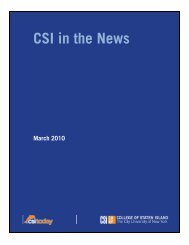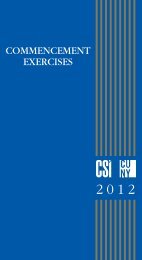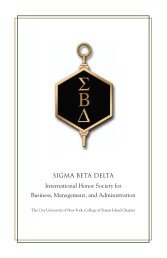csi undergraduate conference on research, scholarship ... - CSI Today
csi undergraduate conference on research, scholarship ... - CSI Today
csi undergraduate conference on research, scholarship ... - CSI Today
Create successful ePaper yourself
Turn your PDF publications into a flip-book with our unique Google optimized e-Paper software.
Research Poster Presentati<strong>on</strong>sP O S T E R 3 3Prejudices and StereotypesAm<strong>on</strong>g Four Major Divisi<strong>on</strong>s ofCollege MajorsBenjamin SilfenFaculty Mentor: Dr. Florette CohenDepartment of PsychologyThe purpose of this study was to investigate thevarying prejudices that exist am<strong>on</strong>g students whoare enrolled in different academic majors. Previous<strong>research</strong> has indicated that a variety of factorsinfluence prejudices between academic disciplines;including physical and psychological gender,ethnicity, pers<strong>on</strong>ality, and academics. This studytouched basis <strong>on</strong> all of these factors, but the mainquesti<strong>on</strong> was whether or not prejudices that existoccur specifically because of which academicmajor an individual is associated with. This studyfocused <strong>on</strong>ly <strong>on</strong> the academic majors at the Collegeof Staten Island, which were divided up into fourspecific groups (social sciences, natural sciences,arts, and businesses). Participants in the study wereasked a variety of questi<strong>on</strong>s c<strong>on</strong>cerning pers<strong>on</strong>alitytraits such as (kind, intelligent, lazy, extraverted, andunderstanding) when it came to analyzing each ofthe four groups of majors. Participants were alsoasked questi<strong>on</strong>s such as which group of majorsthey felt were most difficult, which group they feltwas most important, and the ethnic and genderdisparity am<strong>on</strong>gst the varying groups. Thehypothesis for this study was that there would beempirically significant differences in opini<strong>on</strong>s ofindividuals based <strong>on</strong> which academic major theywere enrolled in. Results about specific prejudiceswill be discussed in further detail.P O S T E R 3 4Effect of Pressure <strong>on</strong> theStability of Water <strong>on</strong> aSuperhydrophobic MembraneMeagan DerbyshireFaculty Mentor: Dr. Alan Ly<strong>on</strong>sDepartment of ChemistrySuperhydrophobic surfaces, both naturallyoccurring and fabricated in the laboratory, arecomposed of small posts. The roughness of thesurface and the hydrophobic material propertiescombine to support water droplets <strong>on</strong> top of theposts (Cassie state), instead of falling between theposts and wetting the entire surface (Wenzel state).When the superhydrophobic surface is placed atthe base of a column, water can be supported <strong>on</strong>top of the posts up to a critical height (orpressure). However, <strong>on</strong>ly a limited height of watercan be supported before the water pressureexceeds the surface tensi<strong>on</strong> and the Cassie statetransiti<strong>on</strong>s to the Wenzel state. This transiti<strong>on</strong>occurs at relatively low pressures and limits theusefulness of superhydrophobic surfaces.The goal of this experiment is to increase the waterpressure that a superhydrophobic surface cansupport. Our approach is to fabricate asuperhydrophobic surface supported <strong>on</strong> a porousmesh instead of a solid base. In this way we canc<strong>on</strong>trol the air pressure below the membraneindependently as the water height is increased.Measurements of the water pressure that can besupported <strong>on</strong> a porous superhydrophobic surfaceas a functi<strong>on</strong> of air pressure below the membranewill be reported.We will explore the characteristics of the surfacesthat make them superhydrophobic, also. Throughthe use of ultraviolet light, we will expose thesurfaces in order to increase theirsuperhydrophobicity. The ultra violet light will beused at varying power settings, distances from thesurface and time intervals in order to increase thec<strong>on</strong>tact angles, simultaneously increasing thesurface’s superhydrophobicity.42
















